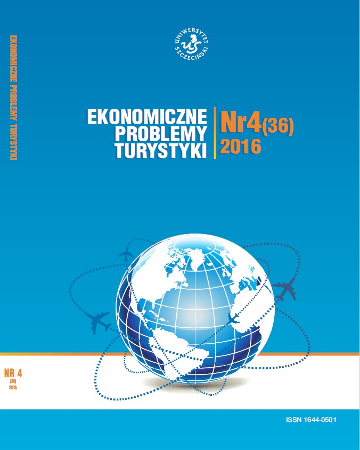
ISSN: 1644-0501
eISSN: 2353-3188
OAI
DOI: 10.18276/ept.2017.1.37-17



Issue archive /
nr 1 (37) 2017
Progi rozwojowe w cyklu życia obszaru turystycznego na przykładzie Wschodniej Dzielnicy Uzdrowiskowej Kołobrzegu
(Thresholds and Development in the Life Cycle of the Tourist Area on the Example of The Kołobrzeg Eastern Spa District)
| Authors: |
Mariusz
Miedziński
Akademia Pomorska Słupsk |
| Keywords: | threshold tourist area life cycle threshold theory TALC resort area Kołobrzeg |
| Data publikacji całości: | 2017 |
| Page range: | 13 (223-235) |
| Klasyfikacja JEL: | E32 F44 R11 |
Abstract
The aim of the study is to indicate the possibility of determining the course of the classic life cycle of the tourist area (TALC) for a small spatial unit which is the Kołobrzeg Eastern Spa District. 40 years ago there was a development of holiday camps and then in their place hotel and sanatorium facilities and apartments were introduced. This process is illustrated in Example I and II of construction line of hotel-sanatorium and apartments on an area of 21 hectares in the immediate vicinity of the beach with a possible further 13 ha development located further away from the beach within the framework of the third construction line. In recent years there has been here an increase in the number of beds from a few hundred to 4000, taking into account further expansion to 9 000 beds. III line of construction may accommodate another 8 000 beds. The possibility of location and scale of the expansion of accommodation facilities in the area are subject to the availability of beaches and their surface which is attributable to 1 holiday-maker (approx. 10 m2/person). The article included the change of management and capacity of accommodation as well as significant physiographic, spatial, functional, communication and urban limitations. On the basis of the urban ratio adopted in the zoning plan (500 persons/ha) as well as the target capacity of the beaches by the availability of 10 m2 for 1 person, development thresholds for the tourism area were indicated and the course of modified life cycle threshold of the tourist area (TTALC) was set. The proposed modification in the earlier publications of the classic TALC to TTALC once again found its confirmation and the result of the study is to prove that for small but intensely developed tourist areas it is possible to determine the thresholds of development and it is reasonable to use the so-called threshold life cycle of the tourist area (TTALC).
Download file
Article file
Bibliography
| 1. | Agarwal, S. (2006). Coastal Resort Restructuring and the TALC Model. W: R.W. Butler (red.), The Tourist Area Life Cycle. Conceptual and Theoretical Issues (s. 201–218). Clevedon: Channel View Publications. |
| 2. | Butler, R.W. (1980). The Concept of a Tourist Area Cycle of Evolution: Implications for Managment of Resources. The Canadian Geographer, 24, 5–12. |
| 3. | Butler, R.W. (2011). Tourist Area Life Cycle. Contemporary Tourist Reviews, OX3 9TJ, 1–33. |
| 4. | Corak, S. (2006). The Modification of the Tourism Area Life Cycle Model for Re(inventing) a Destination: The Case of the Opatija Riviera, Croatia. W: R.W. Butler (red.), The Tourism Area Life Cycle. T. 1: Applications and Modifications (s. 271–287). Clevdon, Buffalo, Toronto: Chanel Viev Publications. |
| 5. | Eberdhard, P. (1980). Zarys wybranych metod z ekonomiki planowania układów osadniczych. Przegląd Geograficzny, LII (3), 519–541. |
| 6. | GUS (2016). Baza noclegowa według stanu w dniu 31 lipca 2016 r. i jej wykorzystanie w I półroczu 2016 roku. Notatka informacyjna. Warszawa. |
| 7. | GUS (2017). Wykorzystanie turystycznych obiektów noclegowych w 2016 roku. Warszawa. |
| 8. | Hadzik, A., Szromek, R.A., Żylak, D. (2010). Konkurencyjność produktu turystycznego uzdrowiska Kołobrzeg. ACTA Oeconomia, 9 (4), 153–164. |
| 9. | Kozłowski, J. (1974). Analiza progowa. Warszawa: PWN. |
| 10. | Kruczek, Z. (2015). The Use of the Butler Cycle and the Chaos Theory in the Interpretation of the Development of the Żegiestów-Zdrój Health Resort, Geoturrism, 3–4 (42–43), 67–74. |
| 11. | Kruczek, Z., Szromek, A.R. (2011). Wykorzystanie modelu R.W. Butlera w interpretacji rozwoju atrakcji turystycznej na przykładzie Kopalni soli w Wieliczce. Folia Turistica, 25 (2), 275–289. |
| 12. | Malisz, B. (1971). Metoda analizy progowej w zastosowaniu do planowania miast i regionów. W: B. Malisz, J. Żurkowski (red.), Metoda analizy progowej (s. 27–47). Warszawa: KPZK PAN. |
| 13. | Miedziński, M. (2012). Miasto Kołobrzeg wiodącym uzdrowiskiem Polski i jednym z centrów turystycznych kraju. W: E. Rydz (red.), Ekonomiczne i organizacyjne aspekty funkcjonowania polskich uzdrowisk (s. 139–150). Słupsk: Wyd. Akademii Pomorskiej. |
| 14. | Miedziński, M. (2013a). Koncentracja ruchu turystycznego w Polsce w latach 2011 i 2012 z uwzględnieniem nadmorskiego regionu turystycznego. Słupskie Prace Geograficzne, 10, 109–126. |
| 15. | Miedziński, M. (2013b). Uzdrowisko Kołobrzeg w świetle zmodyfikowanego cyklu życia obszaru turystycznego |
| 16. | R.W. Butlera oraz teorii progowej B. Malisza. Zeszyty Naukowe Uniwersytetu Szczecińskiego, 784, Ekonomiczne Problemy Turystyki, 3 (23), 209–224. |
| 17. | Miedziński, M. (2015a). Rozwój przestrzeni turystycznej i układu komunikacyjnego Nadmorskiego Obszaru Funkcjonalnego Kołobrzeg – zarys historyczny – stan obecny – perspektywy. Słupskie Prace Geograficzne, 12, 105–121. |
| 18. | Miedziński, M. (2015b). The Creation of the Model Threshold Tourist Area Life Cycle of the Functional Urban Area of Kołobrzeg (Tworzenie modelu progowego cyklu życia obszaru turystycznego na przykładzie miejskiego obszaru funkcjonalnego Kołobrzeg). Zeszyty Naukowe Uniwersytetu Szczecińskiego, 877, Economic Problems of Tourism, 4 |
| 19. | (32), 45–62. |
| 20. | Szromek, A.R. (2007). Ilościowy model prognostyczny popytu na usługi uzdrowiskowe. W: Studia nad turystyką. Prace ekonomiczne i społeczne (s. 225–234). T. 3. Kraków: IGiGP UJ. |
| 21. | Szromek, A.R. (2013). Cechy atrakcyjności polskich uzdrowisk. Zeszyty Naukowe Politechniki Śląskiej, seria. Organizacja i zarządzanie, 64 (1894), 251–264. |